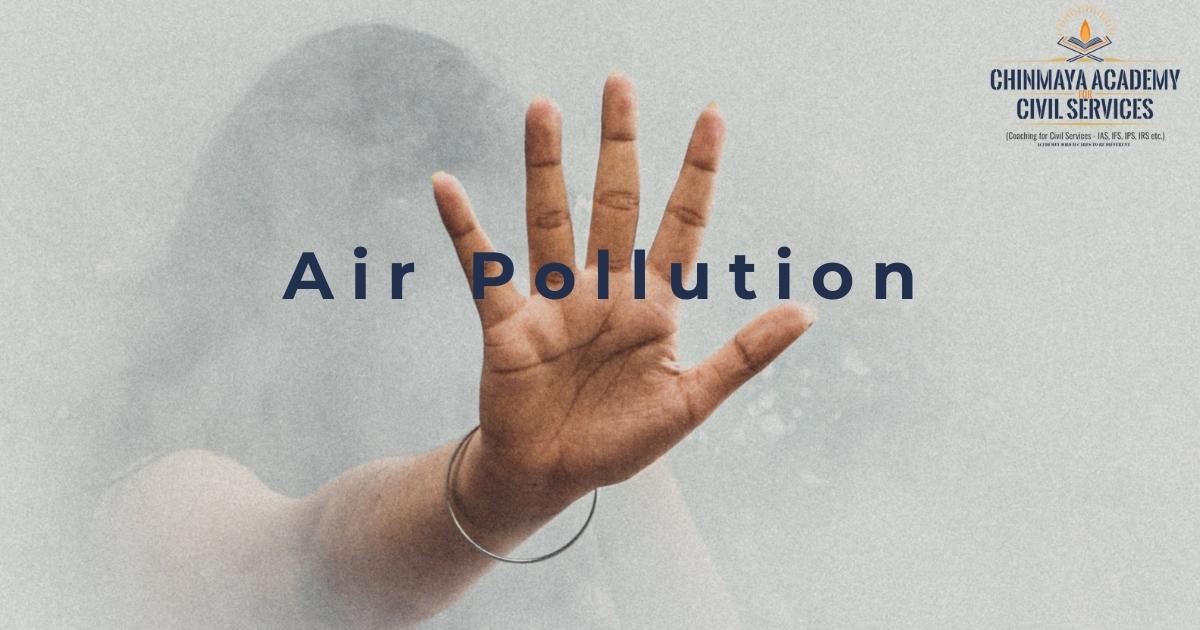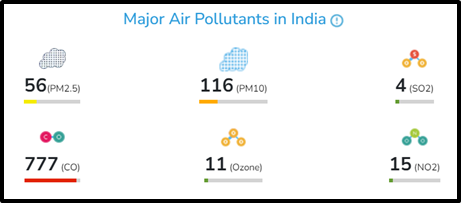
India is the world’s second most polluted country. Fine particulate air pollution (PM2.5) in comparison to WHO guidelines shortens an average Indian’s life expectancy by 5.3 years. Records show that in 2019 over 1.6 million deaths were attributed to poor air quality. This ranged from strokes, diabetes, lung cancer and myocardial infarctions.
WHO defines air pollution as “Air pollution is contamination of the indoor or outdoor environment by any chemical, physical or biological agent that modifies the natural characteristics of the atmosphere.”
Causes of air pollution
- Outdoor air pollution
-
-
- Aerosols & gases from vehicles emissions, construction activities, factories, burning stubble & fossil fuels and wildfire
-
- Indoor air pollution
-
- Harmful gases from burning of organic material, damp, mould smoke, chemicals from cleaning materials
One of the major causes endemic to India is during autumn and winter, huge amounts of stubble are burnt in the fields as a way of preparing the ground for the next crop.
- Primary pollutants: pollutants that directly cause air pollution
- Secondary pollutants: pollutants produced as a result of mixing and interaction of primary pollutants
Effects of air pollution
The effects of air pollution vary with the type of pollutant and the length and level of exposure.
Smog and soot
Produced from combustion of fossil fuels, it can irritate the eyes, throat and even damage the lungs especially among those suffering from asthma or allergies.
Hazardous air pollutants
Most common are mercury, lead, dioxins, and benzene
- Benzene: carcinogen, cause eye, skin, and lung irritation in the short term and blood disorders in the long term
- Dioxin: affect the liver in the short term and harm the immune, nervous, and endocrine systems as well as reproductive functions in long term
- Mercury: attacks the central nervous system
- Lead: causes damage to children’s brains and kidneys
Greenhouse gases
By trapping the earth’s heat in the atmosphere, greenhouse gases lead to warmer temperatures. It leads to climate change causing rising sea levels, more extreme weather, heat-related deaths, and the increased transmission of infectious diseases
Initiatives undertaken

Air (Prevention and Control of Pollution) Act
-
- Enacted in 1981 and amended in 1987
- Objectives:
- provide for the prevention, control and abatement of air pollution in India
- Sets up Central and State Pollution Control Board to monitor air quality and control pollution
Central Pollution Control Board
- a statutory body established under the Water (Prevention and Control of Pollution) Act
- It’s functions and responsibilities are entrusted under the Air (Prevention and Control of Pollution) Act, 1981
- under the Ministry of Environment, Forests and Climate Change
- It monitors air and water quality in India as well as coordinates the activities of the State Pollution Control Boards
National Clean Air Programme
- launched by the Ministry of Environment, Forests and Climate Change (MoEFCC) in 2019
- Initial goal: reduce particulate pollution by 20-30% nationally relative to 2017 levels by 2024 for 102 cities
- Renewed goal: set no national goal but increased the city wise reduction to 40% relative to 2017 levels for 131 cities
- routinely monitors the four air pollutants
- sulphur dioxide (SO2)
- oxides of nitrogen (both NO2 and NO)
- PM10 particulates
- suspended particulate matter (SMP)
SAFAR
- System of Air Quality and Weather Forecasting and Research
- Launched by Ministry of Earth Sciences (MoES)
- National program to assess both the city’s overall pollution level and its local air quality to gauge how clean the air is in a major metropolis
- indigenously developed by the Indian Institute of Tropical Meteorology (IITM), Pune, and operationalized by the India Meteorological Department (IMD)
- Pollutants Monitored:
- PM2.5
- PM10
- Ozone
- Carbon Monoxide (CO)
- Nitrogen Oxides (NOx)
- Sulfur Dioxide (SO2)
- Benzene
- Toluene
- Xylene
- Mercury
National Air Quality Index
- ‘One number- One colour – One description’ guideline launched in 2014
- measurement of air quality is based on eight pollutants:
- Particulate Matter (PM10)
- Particulate Matter (PM2.5)
- Nitrogen Dioxide (NO2)
- Sulphur Dioxide (SO2)
- Carbon Monoxide (CO)
- Ozone (O3)
- Ammonia (NH3)
- Lead (Pb)
- It has six categories of air quality: Good, Satisfactory, Moderately Polluted, Poor, Very Poor, and Severe.
Source includes : AQLI Airquality life Index
Chinmaya Academy – Current affairs have published many articles on Air Pollution. Read on. Write to us at admin@chinmayaias.com to get the links of all our posts on Air Pollution.
Other NEWS
| PPF returns 41 bps behind formula rates |
|
| To Curb Evasion, EU report calls for 2% global wealth tax on billionaires |
|
| Need to clear pending cases proactively |
|
| Two experiments conducted by ISRO |
|
 Chinmaya IAS Academy – Current Affairs Chinmaya IAS Academy – Current Affairs
Chinmaya IAS Academy – Current Affairs Chinmaya IAS Academy – Current Affairs
